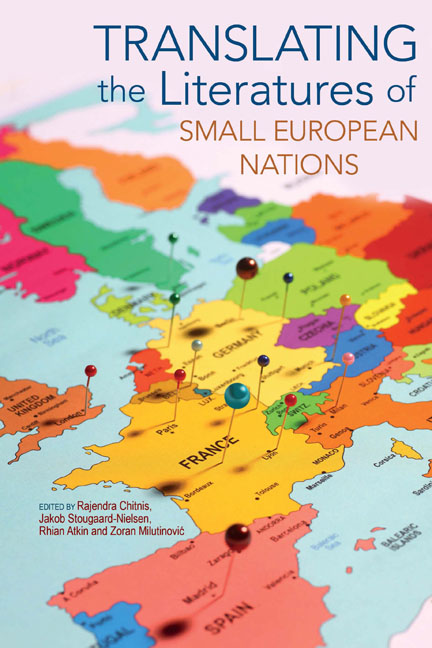Book contents
- Frontmatter
- Contents
- Acknowledgements
- Introduction
- 1 The Global Presentation of Small National Literatures: South Slavs in Literary History and Theory
- 2 Translators as Ambassadors and Gatekeepers: The Case of South Slav Literature
- 3 Supply-driven Translation: Compensating for Lack of Demand
- 4 Literature as Cultural Diplomacy: Czech Literature in Great Britain, 1918–38
- 5 Exporting the Canon: The Mixed Experience of the Dutch Bibliotheca Neerlandica
- 6 Creative Autonomy and Institutional Support in Contemporary Slovene Literature
- 7 Strategies for Success? Evaluating the Rise of Catalan Literature
- 8 Gender, Genre and Nation: Nineteenth-century Swedish Women Writers on Export
- 9 Translating as Re-telling: On the English Proliferation of C.P. Cavafy
- 10 Criminal Peripheries: The Globalization of Scandinavian Crime Fiction and Its Agents
- 11 Literary Translation and Digital Culture: The Transmedial Breakthrough of Poland's The Witcher
- 12 Towards a Multilingual Poetics: Self-translation, Translingualism and Maltese Literature
- 13 Does Size Matter? Questioning Methods for the Study of ‘Small’
- Coda: When Small is Big and Big is Small
- Index
6 - Creative Autonomy and Institutional Support in Contemporary Slovene Literature
- Frontmatter
- Contents
- Acknowledgements
- Introduction
- 1 The Global Presentation of Small National Literatures: South Slavs in Literary History and Theory
- 2 Translators as Ambassadors and Gatekeepers: The Case of South Slav Literature
- 3 Supply-driven Translation: Compensating for Lack of Demand
- 4 Literature as Cultural Diplomacy: Czech Literature in Great Britain, 1918–38
- 5 Exporting the Canon: The Mixed Experience of the Dutch Bibliotheca Neerlandica
- 6 Creative Autonomy and Institutional Support in Contemporary Slovene Literature
- 7 Strategies for Success? Evaluating the Rise of Catalan Literature
- 8 Gender, Genre and Nation: Nineteenth-century Swedish Women Writers on Export
- 9 Translating as Re-telling: On the English Proliferation of C.P. Cavafy
- 10 Criminal Peripheries: The Globalization of Scandinavian Crime Fiction and Its Agents
- 11 Literary Translation and Digital Culture: The Transmedial Breakthrough of Poland's The Witcher
- 12 Towards a Multilingual Poetics: Self-translation, Translingualism and Maltese Literature
- 13 Does Size Matter? Questioning Methods for the Study of ‘Small’
- Coda: When Small is Big and Big is Small
- Index
Summary
As with many other so-called small-nation contexts, research concerning literary translation from Slovene into the global language of English is virtually non-existent. Speakers of English with knowledge of Slovene, a language with two million native speakers, are few. Existing research into this pair of languages tends to originate from the source culture (SC) and therefore often focuses on the translation of literary works into Slovene, rather than examining how and why Slovene literature comes to exist in English translation. While a lack of research into this particular language pair can be easily explained, the lack of research into specific small-nation contexts within the field of translation studies more broadly results in an incomplete picture of the circulation of literary translation. As a result, our understanding of the wider sociocultural functions of translation cannot be considered comprehensive. This is because, as this chapter will show, studies from small-nation contexts like Slovenia complicate the picture that is commonly presented by theoretical translation models developed on the basis of more ‘dominant’ languages. Through an analysis of two case studies that detail two very different routes for translation into English, the research presented in this chapter seeks to construct a clearer understanding of the factors determining the existence and reach of literary translations in this particular small-nation context.
While this chapter examines the translation of Slovene literature into English, it does not claim that the institutional and non-institutional translation practices are exclusive to literary works destined for the anglophone market. Nor does it suggest that English is the most common language into which Slovene literature is translated. Indeed, data from the Index Translationum, though far from comprehensive, suggests that German is the most frequent target language (TL) for literary translation from Slovene. This is also corroborated by recent research from scholars at the University of Ljubljana, who note that German is a language into which Slovene literature is frequently translated, owing to a shared border between Slovenia and Austria, a sense of familiarity between the two SCs and a historical connection between Slovene, Austrian and German cultures (Moe et al., 2010, 47–48). In this chapter, the term ‘Slovene cultural context’ is thus used to describe the arena in which dealings concerning Slovene-to- English literary translations are conducted, which is not to suggest that the strategies described pertaain to the translation of Slovene literature into English alone.
- Type
- Chapter
- Information
- Translating the Literatures of Small European Nations , pp. 109 - 125Publisher: Liverpool University PressPrint publication year: 2019



